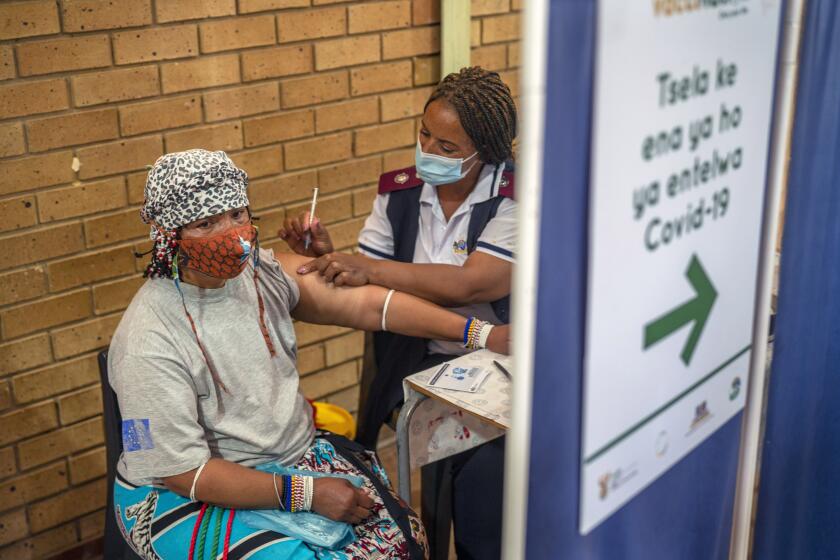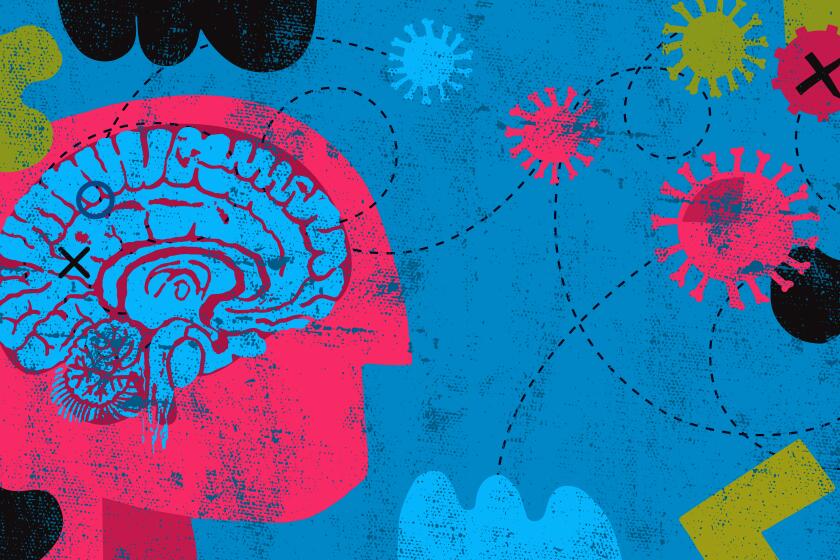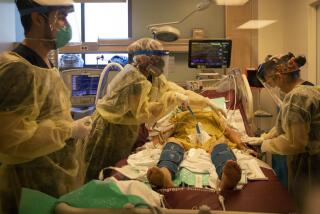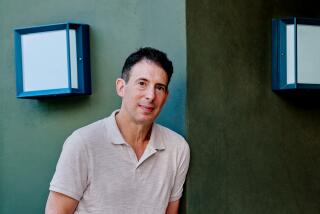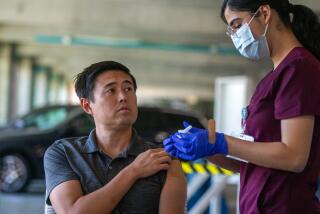A holiday season overshadowed by a new COVID-19 threat
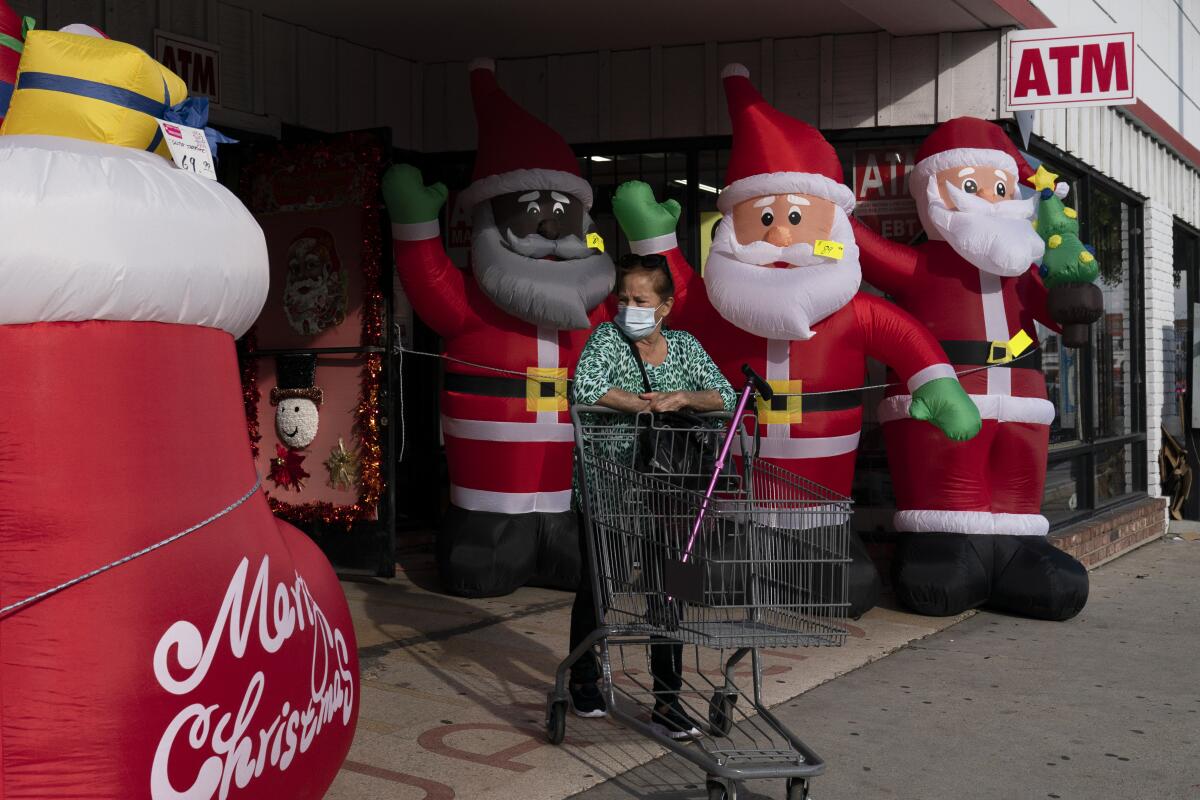
- Share via
With numbers confirming a fifth wave of COVID-19 led by the Omicron variant, the lights of the holiday season have grown suddenly dim. Travel plans, parties and celebrations meant to make up for lost time have been canceled or recalibrated. The disappointment is real, but nature’s rules are often at odds with human intentions.
Adapting, modifying, shapeshifting, SARS-CoV-2 is a predator unlike any other, seeking out new hosts with unsentimental efficiency. Its Delta variant kills 1,300 Americans a day and has helped push the death toll over 800,000. In three months, that number is expected to reach a million.
Now Omicron is further complicating the picture and raising questions about national resolve and endurance at a time of mounting frustration and fatigue.
“Americans have a mixed record in dealing with historical challenges,” said Lawrence Wright, author of “The Plague Year: America in the Time of COVID.”
The pandemic, he argues, presents the country with a profound question: “Is our generation capable of taking the tragedy that we are faced with and making something enduring rather than destructive from it?”
With the fast-spreading but less virulent Omicron variant, the coronavirus may finally be cutting humanity a little slack.
The new variant has not made finding an answer any easier.
Scientists always expected the coronavirus to mutate, and some even suggested that it would become less virulent, as the influenza virus did in the aftermath of the 1918 pandemic.
But the coronavirus has consistently defied expectations. When it first emerged, scientists were surprised at how stable it was, Wright explains, and for nine months, it didn’t appreciably change.
“This was because it was so successful, so efficient in infecting people,” he said. “We had no idea of how much better the virus could be at contagion.”
In the coming weeks, the world will know. Scientists have warned from the start that pandemics require nothing less than global resolve: One country can only be as strong as the most disadvantaged.
Omicron is the evidence. First reported in South Africa in November and then spreading into Europe, it traveled fast on a wave of uncertainty that has bordered on fear and at times made hope feel like denial.
Even though the variant has the earmarks of a weakened virus (highly transmissible and less virulent), the last four weeks have had a familiar and unsettling cadence: surging infections abroad, restricted travel, hospitals overwhelmed, the Y-axis in ascendency — “like a vertical line,” one doctor said.
If early reports are true, two doses of the Pfizer or Moderna vaccines are not enough to stop infection. Boosters are expected to help, but not enough people — only 30% — have received boosters. (And Johnson & Johnson alone seems to do little against the variant.)
Arriving at a time of year when emblems of renewal abound, the news is especially bitter. Hospitalizations in the U.S. have jumped 20% in two weeks. More than 125,000 Americans are testing positive for the coronavirus each day, and in Los Angeles County, infection rates tripled in a week.
Omicron has brought with it a painful lesson. COVID-19 is not going away, and even as some argue that the disease will become as common as the common cold, others warn against easy predictions.
“Alpha stepped up the pace, and Delta really moved things along,” Wright said. “Now the Omicron variant is two to three times more contagious than what was already an amazingly infectious disease. It is discouraging to imagine that it is too fast for us.”
With the variant’s sudden emergence, the country will become even more of a no-man’s land where the compliant and the defiant face off. Mask and vaccine mandates continue to be delayed or challenged; court rulings and appeals are pending.
The third year of the pandemic had promised to be much different. In 2020, Americans abided with the lockdown and orders to stay at home. They eschewed family gatherings, cancelled vacations and told themselves that one lost season would be bearable. Vaccines were starting to be approved, and they thought their sacrifices would be enough.
So much of 2021 was going to be about rebuilding, restoring, recovering, and in the fall — as the summer surge ebbed — many took comfort and solace in the progress that had been made. Routines had been worked out, new habits had been learned, risk calculations had become second-nature.
Tables set at Thanksgiving foreshadowed the promise of what lay ahead, and if the conversations and laughter seemed louder than usual, they only captured a deeper hunger for what had been lost.
Now all that has been swept aside, and the steps taken toward acceptance and accommodation feel as if they were taken in vain. Of course, they weren’t, but thanks to Omicron, they came with an unexpected timestamp.
The NFL has postponed games. Starting lineups in the NBA are in flux. The NHL season is on hold.
Theater productions in New York have been canceled. Colleges are dismissing students early and administering exams online. New recommendations are coming into place: KN95 masks over cloth, more home testing (despite a shortage of kits).
Like a new injury awakening old wounds, Omicron has brought with it unsettled memories of the recent past. When the coronavirus first arrived, it was novel, and the knowledge of respiratory disease was rudimentary. Two years later, the virus has schooled the world.
Where once was the luxury of ignorance is now the knowledge of disruption: of the lines to enter markets, the quiet of empty streets, solitary doom-scrolling as days blurred together, politics infecting civic discourse, the thinly masked rage.
But all of that was over and done, or so many had thought. Trauma, the experts say, takes time to heal, and there has been too little of that, too few voices finding the right words.
We thought we’d have a calm holiday season and a new start in 2022. As Omicron cases surge, COVID anxiety is normal, but how can we manage it?
A chorus belongs to those whose lives are now marked by grief; to healthcare workers abandoned in the fight; teenagers whose precious year was stolen; and children who stumbled over remote learning.
Vaccines allowed most Americans to see and feel all that had changed. A tattered world now begs to be rebuilt as supply chains are in disarray, empty storefronts line Main Street and malls, homeless encampments grow larger, and inflation is on the rise.
“If we want to address the problems that the coronavirus has revealed, then we need to repair civil society and the trust that has been lost,” Wright said.
The last two years have scarred the world and the country, and Omicron threatens to put rebuilding on hold. How it will land on the elderly and ill, on an overburdened healthcare system and the American psyche remains to be seen.
As little as scientists know about this variant today, more will be known tomorrow and in the coming weeks. But until those answers emerge, Americans must live with not knowing and temper their fears with what can be found of reason and hope.
More to Read
Sign up for Essential California
The most important California stories and recommendations in your inbox every morning.
You may occasionally receive promotional content from the Los Angeles Times.
